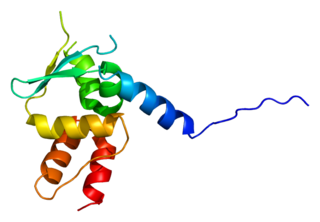
Mothers against decapentaplegic homolog 9 also known as SMAD9, SMAD8, and MADH6 is a protein that in humans is encoded by the SMAD9 gene.

Cadherin EGF LAG seven-pass G-type receptor 2 is a protein that in humans is encoded by the CELSR2 gene.

Frizzled-2(Fz-2) is a protein that in humans is encoded by the FZD2 gene.

Kelch-like ECH-associated protein 1 is a protein that in humans is encoded by the Keap1 gene.

Neuronal acetylcholine receptor subunit alpha-1, also known as nAChRα1, is a protein that in humans is encoded by the CHRNA1 gene. The protein encoded by this gene is a subunit of certain nicotinic acetylcholine receptors (nAchR).

Cullin 3 is a protein that in humans is encoded by the CUL3 gene.

BTB/POZ domain-containing protein 1 is a protein that in humans is encoded by the BTBD1 gene.

BTB/POZ domain-containing protein 2 is a protein that in humans is encoded by the BTBD2 gene.

Serine/threonine protein kinase WNK4 also known as With No lysine (K) protein kinase 4(WNK4), is an enzyme that in humans is encoded by the WNK4 gene. Missense mutations cause a genetic form of pseudohypoaldosteronism type 2, also called Gordon syndrome or Familial Hyperkalemic Hypertension.

Gigaxonin also known as kelch-like protein 16 is a protein that in humans is encoded by the GAN gene.

POZ-, AT hook-, and zinc finger-containing protein 1 is a protein that in humans is encoded by the PATZ1 gene.

Kelch-like protein 12 is a protein that in humans is encoded by the KLHL12 gene.

Synaptotagmin-4 is a protein that in humans is encoded by the SYT4 gene.

BTB/POZ domain-containing protein KCTD13 is a protein that in humans is encoded by the KCTD13 gene.

Kelch-like protein 20 is a protein that in humans is encoded by the KLHL20 gene.

Coiled-coil domain-containing protein 113 also known as HSPC065, GC16Pof6842 and GC16P044152, is a protein that in humans is encoded by the CCDC113 gene. The human CCDC113 gene is located on chromosome 16q21 and encodes 5,304 base pairs of mRNA and 377 amino acids.

Kelch-like protein 7 is a protein that in humans is encoded by the KLHL7 gene.

Tumor necrosis factor receptor superfamily member 27 is a protein that in humans is encoded by the EDA2R gene.

Leucine-zipper-like transcriptional regulator 1 is a protein that in humans is encoded by the LZTR1 gene.

Dachshund homolog 2 is a protein that in humans is encoded by the DACH2 gene.


















